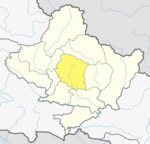Lahachowk
लाहाचोक | |
|---|---|
| Coordinates: 28°19′N 83°55′E / 28.31°N 83.92°E | |
| Country | Nepal |
| Zone | Gandaki Zone |
| District | Kaski District |
| Gaunpalika (Rural Municipality) | Machhapuchchhre |
| Ward | Machhapuchchhre - 4 |
| Population (1991) | |
| • Total | 3,188 |
| Time zone | UTC+5:45 (Nepal Time) |
Lahachowk (Nepali : लाहाचोक ) is a village in Machhapuchchhre Gaunpalika , in the Kaski District, in the Gandaki Zone of northern-central Nepal. According to the 2011 National Population and Housing Census, it had a population of 3,129 in 829 individual households.[1]
Lahachowk is not far from Mount Machhapuchchhre, a mountain in the Annapurna Himal. The village is at the altitude of 1,200 metres (3,937 ft) above sea level. It is about 13 km (8 mi) north-west of Pokhara. The village is ethnically and culturally diverse. Major ethnic groups in the village are Brahmin (43%), Dalit (28%), Chhetri (including Thakuri) (14%), and indigenous groups such as Gurung, Newar and Magar. The society is largely based on a caste structure. Higher castes like Brahmin and Chhetri have greater access to and control over resources and means of production. The people of higher caste generally have a higher educational status. The Hindu religion predominates, followed by Buddhism and a small number of Christians. The society in Lahachowk is a patriarchal one. The major occupation in the village is agriculture, which occupies around 46.7% of the population. Next are the labourers[clarification needed], up to 30.9%. Around 5.3% are working abroad, and government jobs account for 4.9%. Other jobs occupy around 11.5%, while business[clarification needed] accounts for just 0.7%.Madhusudhan Adhikari is the ward chairperson of the village along with elected ward members like Shreedevi, Rabi Adhikari and 2 others.
References
[edit]- ^ "Nepal Census 2001". Nepal's Village Development Committees. Digital Himalaya. Archived from the original on 12 October 2008. Retrieved 30 September 2008.
National Population and Housing Census, 2011
External links
[edit]



Well, that’s interesting to know that Psilotum nudum are known as whisk ferns. Psilotum nudum is the commoner species of the two. While the P. flaccidum is a rare species and is found in the tropical islands. Both the species are usually epiphytic in habit and grow upon tree ferns. These species may also be terrestrial and grow in humus or in the crevices of the rocks.
View the detailed Guide of Psilotum nudum: Detailed Study Of Psilotum Nudum (Whisk Fern), Classification, Anatomy, Reproduction